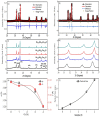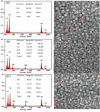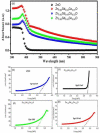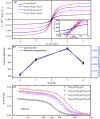Room temperature dilute magnetic semiconductor response in (Gd, Co) co-doped ZnO for efficient spintronics applications
- PMID: 36545077
- PMCID: PMC9761297
- DOI: 10.1039/d2ra06637h
Room temperature dilute magnetic semiconductor response in (Gd, Co) co-doped ZnO for efficient spintronics applications
Abstract
The co-precipitation approach was utilized to experimentally synthesize ZnO, Zn0.96Gd0.04O and Zn0.96-x Gd0.04Co x O (Co = 0, 0.01, 0.03, 0.04) diluted magnetic semiconductor nanotubes. The influence of gadolinium and cobalt doping on the microstructure, morphology, and optical characteristics of ZnO was investigated, and the Gd doping and Co co-doping of the host ZnO was verified by XRD and EDX. The structural investigation revealed that the addition of gadolinium and cobalt to ZnO reduced crystallinity while maintaining the preferred orientation. The SEM study uncovered that the gadolinium and cobalt dopants did not affect the morphology of the produced nanotubes, which is further confirmed through TEM. In the UV-vis spectra, no defect-related absorption peaks were found. By raising the co-doping content, the crystalline phase of the doped samples was enhanced. It was discovered that the dielectric response and the a.c. electrical conductivity display a significant dependent relationship. With the decreasing frequency and increasing Co co-dopant concentration, the ε r and ε'' values decreased. It was also discovered that the ε r, ε'', and a.c. electrical conductivity increased when doping was present. Above room temperature, co-doped ZnO nanotubes exhibited ferromagnetic properties. The ferromagnetic behaviour increased as Gd (0.03) doping increased. Increasing the Co content decreased the ferromagnetic behaviour. It was observed that Zn0.96-x Gd0.04Co x O (x = 0.03) nanotubes exhibit superior electrical conductivity, magnetic and dielectric characteristics compared to pure ZnO. This high ferromagnetism is typically a result of a magnetic semiconductor that has been diluted. In addition, these nanoparticles are utilized to design spintronic-based applications in the form of thin-films.
This journal is © The Royal Society of Chemistry.
Conflict of interest statement
The authors declare that they have no known competing financial interests or personal relationships that could have influenced the work reported in this paper.
Figures







References
-
- Hao Y. et al., Novel magnetic behavior of Mn-doped ZnO hierarchical hollow spheres. J. Nanopart. Res. 2012;14(1):1–9. - PubMed
-
- Prinz G. A. Magnetoelectronics. Science. 1998;282(5394):1660–1663. - PubMed
-
- Khan R. et al., Structure and magnetic properties of (Co, Ce) co-doped ZnO-based diluted magnetic semiconductor nanoparticles. J. Mater. Sci.: Mater. Electron. 2021;32(19):24394–24400.
-
- Li P. et al., Structural and optical properties of Co-doped ZnO nanocrystallites prepared by a one-step solution route. J. Lumin. 2012;132(1):220–225.
-
- Khan R. et al., Effect of Sn-doping on the structural, optical, dielectric and magnetic properties of ZnO nanoparticles for spintronics applications. J. Mater. Sci.: Mater. Electron. 2021;32(16):21631–21642.
LinkOut - more resources
Full Text Sources

